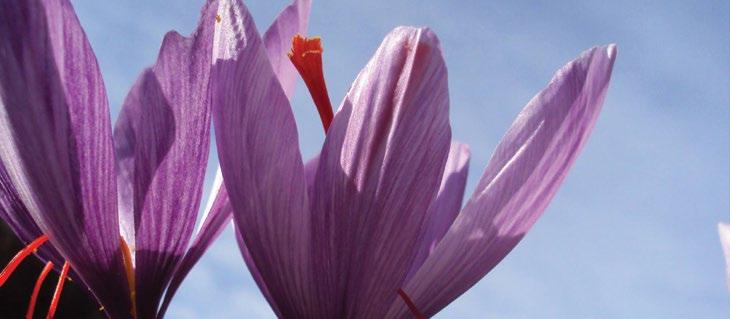
6 minute read
All that glitters is not always gold
ALL THAT GLITTERS IS
NOT ALWAYS GOLD
Words by Mike Nichols
A handful of growers across New Zealand are trying their hand at cultivating the highly prized, exotic red spice, saffron.
Extracted from the flower Crocus sativus, it is one of the most expensive spices in the world, with a per gram value similar to that of gold. The cost is justified when you consider that it is harvested entirely by hand. Each individual saffron thread must be carefully removed from the flower, with each flower producing just three strands of the delicate red threads. More than 150 flowers are required to produce just a single gram of saffron. It is an Incredibly labour-intensive crop. For this reason, 90% of the world’s saffron is produced in Iran by peasant farmers. Harvesting occurs over a period of four to five weeks in autumn, when the corms begin to flower and grasslike leaves appear. In the spring, replacement corms are produced in the ground, just above the mother corm. On the surface, saffron would appear to be an ideal crop to grow in New Zealand – where distance from market and freight costs are major constraints – but in fact, our high labour costs and the intensive labour required means few operations opt to grow such a crop. Owner-operators of Kiwi Saffron, Jo and Steve Daley, are among the bold who decided to try their hand at growing saffron on a site in Te Anau.
“Steve and I began growing saffron in 2013,” says Jo. “I wanted to order 500 corms to plant for home use, but Steve placed an order for 40,000 corms… that’s really how Kiwi Saffron Ltd was born.”
Their farm has proved to be an ideal climate for growing the sought-after spice.
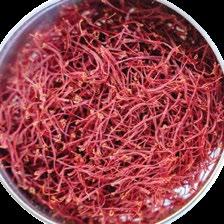
Red gold - saffron holds a similar per gram value to gold
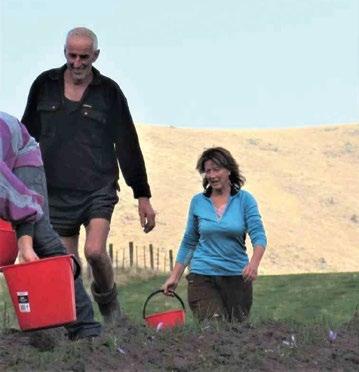
Steve (left) and Jo Daley are among the few growers in New Zealand harvesting saffron and have built a successful business from their crop
“Our site is technically too far south to be considered for corm growing due to higher rainfall. Constant wet feet would promote rot or botrytis in the corms,” says Jo. “But with our site’s high elevation and rather sandy soil, drainage has not proved to be a huge problem.”
A bonus of their southern location is also the high level of ultraviolet (UV) light. “High UV exposure results in higher colour, flavour and aroma in the saffron, the three most sought after attributes of great saffron,” says Jo. Processing involves handpicking flowers in the early morning, plucking stigmas from the flowers indoors and drying via dehydrators for a consistent time, at an even temperature. “High temperature drying prevents bacteria and ensures long shelf life if kept away from heat and light in storage,” says Jo. Flowers are picked and processed on the same day to preserve freshness and vitality. Kiwi Saffron processes only the tips of the saffron thread, discarding the white and orange parts of the stigma. The result is a product called Sargol, which is recognised by its rich red colouring and considered as the highest quality saffron available on the market. “We do lose a little volume with not including yellow parts of the stigma, but the result is one of the purest saffron products available,” says Jo. “Our Sargol consistently scores highly against ISO 3632-2 standards, placing it into pharmaceutical grade. It lends itself to many medicinal and nutritional supplements too.” Despite being a labour-intensive crop, Steve and Jo say they still enjoy the job. “But we both enjoy the time in the paddock and spent around the table plucking the stigmas with our helpers,” says Jo. “Folk have gathered in this way for centuries to process saffron. The camaraderie is great and a lot is learned and shared by all involved.”
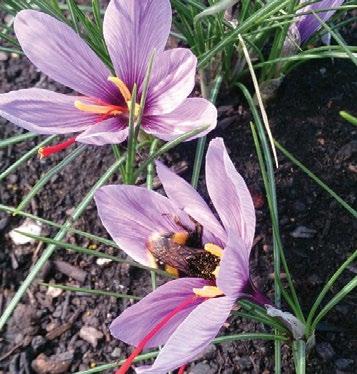
Kiwi Saffron’s corms in flower
Like other growers around the country, the biggest challenge for the Daleys right now is labour. “Covid-19 has hugely affected our harvest and we do not have ready access to the WWOOFing [Worldwide Opportunities on Organic Farms] community that we normally enjoy or travelling backpackers looking for seasonal work.”
FIG 1 FIG 2
Saffron corms in egg trays
If saffron is to become a more profitable and more commonly grown crop in New Zealand, it will require considerable effort to develop growing processes and production methods that address these labour shortages and improve harvesting efficiency. Robotics would certainly make the harvesting of saffron less laborious, but it remains to be seen whether such technology could be used without compromising the flowers and the quality of the delicate red threads housed inside them.
“We feel robotics is perhaps the way forward,” says Jo. “But that technology is currently very expensive and out of reach to small companies and growers. It would be great to see research and development easily accessible and shared by growers as the industry progresses.”
Technology might also be considered for creating an ideal growing environment for the corms. Is it possible to ‘persuade’ saffron to flower at any time of the year? After corms have experienced a period of high temperature in summer, saffron begins to flower in autumn as the temperature falls. The challenge would be to mimic this environment for different sets of corms throughout the year in order to achieve a continuous supply of flowers. We also know that under appropriate temperature conditions, saffron will flower in egg trays without any growing medium (Figures 1, 2, 3 & 4).
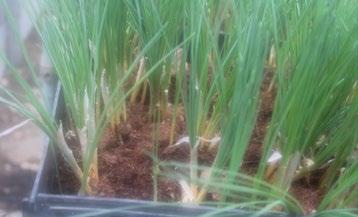
FIG 3 FIG 4
Saffron corms flowering in egg trays
This flowering occurred under incandescent lights, posing the question of whether the flowering process actually requires light. It also poses the question of whether the chemical content of the saffron spice might be enhanced by using lights with specific wavelengths (ultraviolet?) or whether this is already pre-determined by the chemical content of the corm.
Immediately after flowering, the corms can then be planted into deep trays filled with growing medium to complete their growth and develop replacement corms (Figure 5). The Daleys have experienced light enhancing the crop themselves, with Te Anau’s higher than usual level of UV light intensifying the colour, flavour and aroma of their saffron.
With dried saffron spice currently valued at a whopping $US2,500/kg, a peasant industry may finally be coming of age.
Table 1. Effect of corm size (weight) on flower production
Corm weight (g) Flowers/corm
>30 4.0
20–30 2.7
10–20 2.4
<10 1.6
FIG 5
Saffron growing in greenhouse after flowering









